
House of Schwarzenberg
Encyclopedia
Schwarzenberg is the name of a Franconia
n and Bohemia
n aristocratic family.
family (the non-Schwarzenberg portion died out in 1958) was created when Erkinger I of Seinsheim acquired the Franconia
n barony of Schwarzenberg, the castle Schwarzenberg
and the title Baron of Schwarzenberg, in 1405–21. At this time, they also possessed some fiefdoms in Bohemia
. In 1599 the Schwarzenbergs were elevated to Counts and in 1670 to Princes. The House of Schwarzenberg came into extensive land holdings in Bohemia in 1661 through a marriage alliance with the House of Eggenberg
. In the 1670s, they established their primary seat in Bohemia. Until 1918 their primary residence was in Český Krumlov
, Bohemia
(now in the Czech Republic
).
In the late 18th century, the House of Schwarzenberg was divided into two titled lines (majorat
s). The elder line died out in the male line in 1965 with Heinrich Schwarzenberg, the 11th Prince of Schwarzenberg. The second line was established with Prince Karl Philipp of Schwarzenberg at Orlík
, Murau
and Vienna
. Today the two lines are united under the current head of the house, Prince Karl VII of Schwarzenberg
, who serves as the current minister of foreign affairs of the Czech Republic.

 The ancestral coat of the lords of Seinsheim consisted of vertical stripes in silver and blue.
The ancestral coat of the lords of Seinsheim consisted of vertical stripes in silver and blue.
In 1566, when John Younger of Schwarzenberg was ennobled, he added an inescutcheon with a silver tower for Schwarzenberg.
In 1599 Adolf zu Schwarzenberg added a quarter
showing the head of a Turk
pecked by a raven
, to symbolize the conquest of a Turkish fortress in Hungary
known in German as Raab
('Raven').
In 1688, quarters were added for the domains of Sulz
, Brandis (canting arms
: a brand) and the Landgraviate of Klettgau
.
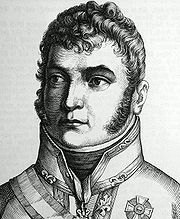
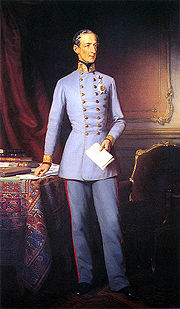
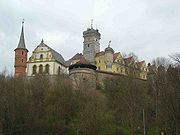


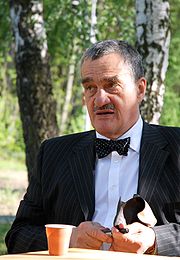 The House of Schwarzenberg produced many military commanders, politicians, church dignitaries (including an Archbishop of Prague
The House of Schwarzenberg produced many military commanders, politicians, church dignitaries (including an Archbishop of Prague
), innovators and patrons of the arts. They were related to a number of European aristocratic families, notably to the Lobkowicz
family. By name, notable members are:
and Orlík Castle
. The family also acquired property of the House of Rosenberg
. They created ponds, planted forests and introduced new technologies in agriculture.
Upon the establishment of the Protectorate of Bohemia and Moravia
, the possessions of Prince Adolf of Schwarzenberg were seized by the Nazi authorities. He himself managed to flee, while his cousin and heir Duke Heinrich of Krumlov was arrested and deported. After World War II the Czechoslovakia
n government by law No. 143/1947 from August 13, 1947 (Lex Schwarzenberg) stated that the assets of the Schwarzenberg-Hluboká primogeniture passed to the Land of Bohemia.
(died 917) as their ancestor.
In 1599, the barony was raised to an Imperial county.
On 14 July 1670, the county was raised to an Princely county and, the following year, to a Princely landgraviate.
In November 1918 the Austro-Hungarian Empire ceases to exist.
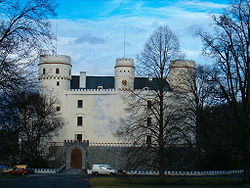
All the other members of the family are not Dukes of Krumlov and they should be addressed without the "the" in front of the title prince. In the German language they are just "Prinz" and the son of the head of the family should be addressed with the titel "Erbprinz".
Franconia
Franconia is a region of Germany comprising the northern parts of the modern state of Bavaria, a small part of southern Thuringia, and a region in northeastern Baden-Württemberg called Tauberfranken...
n and Bohemia
Bohemia
Bohemia is a historical region in central Europe, occupying the western two-thirds of the traditional Czech Lands. It is located in the contemporary Czech Republic with its capital in Prague...
n aristocratic family.
History
The family was first mentioned in 1172. A branch of the SeinsheimSeinsheim
Seinsheim is a municipality in the district of Kitzingen in Bavaria in Germany. It is best known for its connection with the countly Seinsheim family which died out with the exception of the princely House of Schwarzenberg branch of the family....
family (the non-Schwarzenberg portion died out in 1958) was created when Erkinger I of Seinsheim acquired the Franconia
Franconia
Franconia is a region of Germany comprising the northern parts of the modern state of Bavaria, a small part of southern Thuringia, and a region in northeastern Baden-Württemberg called Tauberfranken...
n barony of Schwarzenberg, the castle Schwarzenberg
Scheinfeld
Scheinfeld is a town in the Neustadt -Bad Windsheim district, in Bavaria, Germany. It is situated 14 km northwest of Neustadt , and 40 km east of Würzburg. Schloss Schwarzenberg is adjacent to the town. The town is home to an Adidas testing factory....
and the title Baron of Schwarzenberg, in 1405–21. At this time, they also possessed some fiefdoms in Bohemia
Kingdom of Bohemia
The Kingdom of Bohemia was a country located in the region of Bohemia in Central Europe, most of whose territory is currently located in the modern-day Czech Republic. The King was Elector of Holy Roman Empire until its dissolution in 1806, whereupon it became part of the Austrian Empire, and...
. In 1599 the Schwarzenbergs were elevated to Counts and in 1670 to Princes. The House of Schwarzenberg came into extensive land holdings in Bohemia in 1661 through a marriage alliance with the House of Eggenberg
Eggenberg
-Places:*Eggenberg , a district of the Austrian city of Graz*Schloss Eggenberg , a palace in Graz*Eggenberg, Switzerland, a village in the municipality of Mühleberg, canton of Berne*Eggenberg House, city palace in Sopron , Hungary...
. In the 1670s, they established their primary seat in Bohemia. Until 1918 their primary residence was in Český Krumlov
Český Krumlov
Český Krumlov is a small city in the South Bohemian Region of the Czech Republic, best known for the fine architecture and art of the historic old town and Český Krumlov Castle...
, Bohemia
Bohemia
Bohemia is a historical region in central Europe, occupying the western two-thirds of the traditional Czech Lands. It is located in the contemporary Czech Republic with its capital in Prague...
(now in the Czech Republic
Czech Republic
The Czech Republic is a landlocked country in Central Europe. The country is bordered by Poland to the northeast, Slovakia to the east, Austria to the south, and Germany to the west and northwest....
).
In the late 18th century, the House of Schwarzenberg was divided into two titled lines (majorat
Majorat
Majorat is the right of succession to property according to age . A majorat would be inherited by the oldest son, or if there was no son, the nearest relative. This law existed in some of the European countries and was designed to prevent the distribution of wealthy estates between many members of...
s). The elder line died out in the male line in 1965 with Heinrich Schwarzenberg, the 11th Prince of Schwarzenberg. The second line was established with Prince Karl Philipp of Schwarzenberg at Orlík
Orlík nad Vltavou
Orlík nad Vltavou is a village in the South Bohemian Region of the Czech Republic. The village was formerly called Staré Sedlo, named after the chateau. "nad Vltavou" means in Czech language "upon the river Vltava" and situated on the left river bank, upon Orlík Dam. Near the village there stand...
, Murau
Murau
Murau is the capital of the district of the same name in Styria, located along the Mur river. It has a population of 2,331.-History:The area was already settled in the Bronze Age and Roman time, for the first time document which mentioned Murau was in the year 1250.During the Second World War a...
and Vienna
Vienna
Vienna is the capital and largest city of the Republic of Austria and one of the nine states of Austria. Vienna is Austria's primary city, with a population of about 1.723 million , and is by far the largest city in Austria, as well as its cultural, economic, and political centre...
. Today the two lines are united under the current head of the house, Prince Karl VII of Schwarzenberg
Karel Schwarzenberg
Karel Schwarzenberg or Karel, Prince of Schwarzenberg , 7...
, who serves as the current minister of foreign affairs of the Czech Republic.
Coat of arms


In 1566, when John Younger of Schwarzenberg was ennobled, he added an inescutcheon with a silver tower for Schwarzenberg.
In 1599 Adolf zu Schwarzenberg added a quarter
Quartering (heraldry)
Quartering in heraldry is a method of joining several different coats of arms together in one shield by dividing the shield into equal parts and placing different coats of arms in each division....
showing the head of a Turk
Turkish people
Turkish people, also known as the "Turks" , are an ethnic group primarily living in Turkey and in the former lands of the Ottoman Empire where Turkish minorities had been established in Bulgaria, Cyprus, Bosnia and Herzegovina, Georgia, Greece, Kosovo, Macedonia, and Romania...
pecked by a raven
Raven
Raven is the common name given to several larger-bodied members of the genus Corvus—but in Europe and North America the Common Raven is normally implied...
, to symbolize the conquest of a Turkish fortress in Hungary
Hungary
Hungary , officially the Republic of Hungary , is a landlocked country in Central Europe. It is situated in the Carpathian Basin and is bordered by Slovakia to the north, Ukraine and Romania to the east, Serbia and Croatia to the south, Slovenia to the southwest and Austria to the west. The...
known in German as Raab
Gyor
-Climate:-Main sights:The ancient core of the city is Káptalan Hill at the confluence of three rivers: the Danube, Rába and Rábca. Püspökvár, the residence of Győr’s bishops can be easily recognised by its incomplete tower. Győr’s oldest buildings are the 13th-century dwelling tower and the...
('Raven').
In 1688, quarters were added for the domains of Sulz
Sulz am Neckar
Sulz am Neckar is a town in the district of Rottweil, in Baden-Württemberg, Germany. It is situated on the river Neckar, 22 km north of Rottweil, and 19 km southeast of Freudenstadt....
, Brandis (canting arms
Canting arms
Canting arms are heraldic bearings that represent the bearer's name in a visual pun or rebus. The term cant came into the English language from Anglo-Norman cant, meaning song or singing, from Latin cantāre, and English cognates include canticle, chant, accent, incantation and recant.Canting arms –...
: a brand) and the Landgraviate of Klettgau
Klettgau
Klettgau is a group of towns in the district of Waldshut in Baden-Württemberg in Germany. Landgraviat of Klettgau to 1812.There is a border crossing into Switzerland at Erzingen to Trasadingen in Schaffhausen canton....
.
Members






Prague
Prague is the capital and largest city of the Czech Republic. Situated in the north-west of the country on the Vltava river, the city is home to about 1.3 million people, while its metropolitan area is estimated to have a population of over 2.3 million...
), innovators and patrons of the arts. They were related to a number of European aristocratic families, notably to the Lobkowicz
Lobkowicz
The Lobkowicz family is one of the oldest still existing Bohemian noble families dating back to the 14th century...
family. By name, notable members are:
- Johann of SchwarzenbergJohann of SchwarzenbergJohann of Schwarzenberg was a German moralist and reformer who, as judge of the episcopal court at Bamberg, introduced a new code of evidence which amended the procedure then prevalent in Europe by securing for the accused a more impartial hearing.In 1507, at the direction of the...
(1463–1528), Bamberg judgeJudgeA judge is a person who presides over court proceedings, either alone or as part of a panel of judges. The powers, functions, method of appointment, discipline, and training of judges vary widely across different jurisdictions. The judge is supposed to conduct the trial impartially and in an open...
, and friend of Martin LutherMartin LutherMartin Luther was a German priest, professor of theology and iconic figure of the Protestant Reformation. He strongly disputed the claim that freedom from God's punishment for sin could be purchased with money. He confronted indulgence salesman Johann Tetzel with his Ninety-Five Theses in 1517... - Adam, Count of SchwarzenbergAdam, Count of SchwarzenbergAdam Graf von Schwarzenberg was a German official who advised George William, Elector of Brandenburg, during the Thirty Years' War and served as the Master of the Johanniterorden, the Bailiwick of Brandenburg of the Order of Saint John .- Early life :Schwarzenberg was born in Gimborn in the County...
(1583–1641), advisor of George William, Elector of BrandenburgGeorge William, Elector of BrandenburgGeorge William of Brandenburg , of the Hohenzollern dynasty, was margrave and elector of Brandenburg and duke of Prussia from 1619 until his death. His reign was marked by ineffective governance during the Thirty Years' War... - Georg Ludwig, Count von Schwarzenberg (1586–1646), Austrian statesman during the Thirty Years War
- Prince Karl Philipp I of SchwarzenbergKarl Philipp, Prince of SchwarzenbergKarl Philipp Fürst zu Schwarzenberg Karl Philipp Fürst zu Schwarzenberg Karl Philipp Fürst zu Schwarzenberg (or Charles Philip, Prince of Schwarzenberg (April 18, 1771 – October 15, 1820) was an Austrian field marshal.- Life :...
(1771–1820), Austrian generalGeneralA general officer is an officer of high military rank, usually in the army, and in some nations, the air force. The term is widely used by many nations of the world, and when a country uses a different term, there is an equivalent title given....
and field marshalField MarshalField Marshal is a military rank. Traditionally, it is the highest military rank in an army.-Etymology:The origin of the rank of field marshal dates to the early Middle Ages, originally meaning the keeper of the king's horses , from the time of the early Frankish kings.-Usage and hierarchical... - Prince Felix of SchwarzenbergPrince Felix of SchwarzenbergPrinz Felix zu Schwarzenberg was an Austrian statesman who restored the Habsburg Empire as a European power following the disorders of 1848....
(1800–1852), Austrian statesman - Friedrich Johannes Jacob Celestin von SchwarzenbergFriedrich Johannes Jacob Celestin von SchwarzenbergFriedrich Johannes Jacob Celestin von Schwarzenberg, sometimes Friedrich Johannes Joseph Schwarzenberg or in Czech Bedřich Schwarzenberg was a Catholic Cardinal of the nineteenth century in Austria and the Kingdom of Bohemia.He was the youngest child of John Joseph, Prince of Schwarzenberg and of...
(1809–1885), Archbishop of Salzburg and Prague - Karel SchwarzenbergKarel SchwarzenbergKarel Schwarzenberg or Karel, Prince of Schwarzenberg , 7...
(1937- ), Czech politician, the current Minister of Foreign Affairs of the Czech Republic
Bohemia
The Schwarzenberg property in Bohemia included the Duchy of Krumlov, the town of PrachaticePrachatice
Prachatice is a town in the South Bohemian Region, Czech Republic.-History:The town of Prachatice has its origins in the 11th century, following the beginning of trade on the "Golden Path"...
and Orlík Castle
Orlík nad Vltavou
Orlík nad Vltavou is a village in the South Bohemian Region of the Czech Republic. The village was formerly called Staré Sedlo, named after the chateau. "nad Vltavou" means in Czech language "upon the river Vltava" and situated on the left river bank, upon Orlík Dam. Near the village there stand...
. The family also acquired property of the House of Rosenberg
House of Rosenberg
The Rosenberg family was the most significant and influential Bohemian noble family playing important role in Czech medieval history from 13th century till 1611...
. They created ponds, planted forests and introduced new technologies in agriculture.
Upon the establishment of the Protectorate of Bohemia and Moravia
Protectorate of Bohemia and Moravia
The Protectorate of Bohemia and Moravia was the majority ethnic-Czech protectorate which Nazi Germany established in the central parts of Bohemia, Moravia and Czech Silesia in what is today the Czech Republic...
, the possessions of Prince Adolf of Schwarzenberg were seized by the Nazi authorities. He himself managed to flee, while his cousin and heir Duke Heinrich of Krumlov was arrested and deported. After World War II the Czechoslovakia
Czechoslovakia
Czechoslovakia or Czecho-Slovakia was a sovereign state in Central Europe which existed from October 1918, when it declared its independence from the Austro-Hungarian Empire, until 1992...
n government by law No. 143/1947 from August 13, 1947 (Lex Schwarzenberg) stated that the assets of the Schwarzenberg-Hluboká primogeniture passed to the Land of Bohemia.
Castles and palaces
The Schwarzenberg holdings included the following castles:- Schloß Schwarzenberg at ScheinfeldScheinfeldScheinfeld is a town in the Neustadt -Bad Windsheim district, in Bavaria, Germany. It is situated 14 km northwest of Neustadt , and 40 km east of Würzburg. Schloss Schwarzenberg is adjacent to the town. The town is home to an Adidas testing factory....
, FranconiaFranconiaFranconia is a region of Germany comprising the northern parts of the modern state of Bavaria, a small part of southern Thuringia, and a region in northeastern Baden-Württemberg called Tauberfranken... - Gimborn CastleGimborn CastleGimborn Castle is a former moated castle situated in a remote valley of the upper Leppe in the municipality of Marienheide in the Oberbergischer Kreis of North Rhine-Westphalia, Germany.-History:...
in the RhinelandRhinelandHistorically, the Rhinelands refers to a loosely-defined region embracing the land on either bank of the River Rhine in central Europe....
, from 1631 until 1874 - Krumlov Castle in Český KrumlovČeský KrumlovČeský Krumlov is a small city in the South Bohemian Region of the Czech Republic, best known for the fine architecture and art of the historic old town and Český Krumlov Castle...
, South BohemiaSouth Bohemian RegionSouth Bohemian Region is an administrative unit of the Czech Republic, located mostly in the southern part of its historical land of Bohemia, with a small part in southwestern Moravia...
, held from 1719 to 1947 - Hluboká Castle in Hluboká nad VltavouHluboká nad VltavouHluboká nad Vltavou ) is a town in the South Bohemian Region of the Czech Republic, near České Budějovice. This town was a favourite of Charles IV, who often visited when residing in České Budějovice...
, South Bohemia, acquired by Johann Adolf I of Schwarzenberg in 1661, held until 1947 - VimperkVimperkVimperk is a town in the South Bohemian Region of the Czech Republic. In 2000 the town had 8,090 inhabitants. Vimperk is situated in the Šumava region in the Volyňka River valley among the foothills of the Boubín Mountains. The town elevation is 700 metres above sea level.Vimperk is surrounded by...
(Winterberg) Castle, South Bohemia - TřeboňTrebonTřeboň is a historical town in South Bohemian Region of Czech Republic. The population stands at 8,862 .-History:Třeboň was established around the middle of the 12th century. In 1366 the House of Rožmberk become owner of the estate...
Castle, South Bohemia - Orlík CastleOrlík CastleOrlík Castle is a chateâu located 500 m northeast of the village of Orlík nad Vltavou, in the northern part of the District of Písek, in the South Bohemia Region of the Czech Republic...
in Orlík nad VltavouOrlík nad VltavouOrlík nad Vltavou is a village in the South Bohemian Region of the Czech Republic. The village was formerly called Staré Sedlo, named after the chateau. "nad Vltavou" means in Czech language "upon the river Vltava" and situated on the left river bank, upon Orlík Dam. Near the village there stand...
, South Bohemia, restored in 1992 - ČimeliceCimeliceČimelice is a bigger village on the north of Písek District, on the way which connecting South Bohemia with Prague and which is widely known as "R4" or "Strakonická" ....
Castle, South Bohemia - Zvikov CastleZvíkov CastleZvíkov , often called "the king of Czech castles", is a castle located at the junction of the Vltava and Otava rivers, some 15 km north of Písek, in the South Bohemian Region, Czech Republic, next to the village Zvíkovské Podhradí. It is placed on a hard to access and steep promontory above the...
, South Bohemia - Schloss MurauMurauMurau is the capital of the district of the same name in Styria, located along the Mur river. It has a population of 2,331.-History:The area was already settled in the Bronze Age and Roman time, for the first time document which mentioned Murau was in the year 1250.During the Second World War a...
, Styria - Palais Schwarzenberg in PraguePraguePrague is the capital and largest city of the Czech Republic. Situated in the north-west of the country on the Vltava river, the city is home to about 1.3 million people, while its metropolitan area is estimated to have a population of over 2.3 million...
(until 1947) - Palais SchwarzenbergPalais SchwarzenbergPalais Schwarzenberg is a Baroque palace in front of Schwarzenbergplatz, Landstraße, the 3rd district of Vienna, Austria. It is owned by the princely Schwarzenberg family....
in ViennaViennaVienna is the capital and largest city of the Republic of Austria and one of the nine states of Austria. Vienna is Austria's primary city, with a population of about 1.723 million , and is by far the largest city in Austria, as well as its cultural, economic, and political centre... - Palais Salm in Prague (until 1947)
Lords of Seinsheim
The House of Seinsheim regarded Erchanger, Duke of SwabiaErchanger, Duke of Swabia
Erchanger was the duke of Swabia from September 915 to his death. He was the son of Berthold I, count palatine of Swabia, who is sometimes called Erchanger as well, in which case the duke is Erchanger II...
(died 917) as their ancestor.
- Conrad
- ...
- Apollonius d. Ä. (died 1311)
- ...
- Hildebrand (died 1386)
- Michael (I.) (died 1399)
- Erkinger (VI.) (1362–1437) 1409 founded Astheim CharterhouseAstheim CharterhouseAstheim Charterhouse, also known as Marienbrück Charterhouse was a Carthusian monastery, or charterhouse, in Astheim near Volkach in Kitzingen, Bavaria, Germany.- History :...
with his first wife Anna von BibraBibra familyFor other Bibra and Bibran entries, go to Bibra disambiguation pageBibra family was one of the leading families in Franconia and Thuringia from the mid-15th century to about 1600. Later on the family rose from Reichsritter to Reichsfreiherr...
, received Schwarzenberg 1420, became baron of Schwarzenberg in 1429 and bought Hohenlandsberg 49.595034°N 10.297960°E in 1435: All Schwarzenbergs descend from Erkinger and his two wives, Anna von Bibra (died 1418) and Barbara von Abensberg (died 1448).
Barons of Schwarzenberg
- 1420–1437: Erkinger I (same as Erkinger VI above)
- 1437–1469: Michael II
- 1469–1499: Michael III
- 1499–1510: Erkinger II
- 1510–1526: Wilhelm I
- 1526–1557: Wilhelm II
- 1557–1599: AdolfAdolf von SchwarzenbergCount Adolf von Schwarzenberg was a renowned general of the Holy Roman Empire whose sword, along with that of his descendant Prince Karl Philipp, is preserved in the arsenal of Vienna. He fought in the wars of religion, but was chiefly distinguished in the wars on the Eastern frontier against the...
, count until 1600
In 1599, the barony was raised to an Imperial county.
Counts of Schwarzenberg
- 1599–1600: AdolfAdolf von SchwarzenbergCount Adolf von Schwarzenberg was a renowned general of the Holy Roman Empire whose sword, along with that of his descendant Prince Karl Philipp, is preserved in the arsenal of Vienna. He fought in the wars of religion, but was chiefly distinguished in the wars on the Eastern frontier against the...
, baron since 1557 - 1600–1641: Adam IAdam, Count of SchwarzenbergAdam Graf von Schwarzenberg was a German official who advised George William, Elector of Brandenburg, during the Thirty Years' War and served as the Master of the Johanniterorden, the Bailiwick of Brandenburg of the Order of Saint John .- Early life :Schwarzenberg was born in Gimborn in the County...
- 1641–1670: Johann Adolf I
On 14 July 1670, the county was raised to an Princely county and, the following year, to a Princely landgraviate.
Princes of Schwarzenberg
- 1670–1683: Johann Adolf I
- 1683–1703: Ferdinand Wilhelm Eusebius
- 1703–1732: Adam II Franz Karl, Duke of Krumlov from 1719
- 1732–1782: Joseph I Adam
- 1782–1789: Johann I
PrimogeniturePrimogeniturePrimogeniture is the right, by law or custom, of the firstborn to inherit the entire estate, to the exclusion of younger siblings . Historically, the term implied male primogeniture, to the exclusion of females...
(Hluboká)- 1789–1833: Joseph II, son of Johann I, Duke of Krumlov
- 1833–1888: Johann Adolf II
- 1888–1914: Adolf Joseph
- 1914–1918: Johann II
SecundogenitureSecundogenitureA secundogeniture was a dependent territory given to a younger son of a princely house and his descendants, creating a cadet branch. This was a special form of inheritance...
(Orlík)- 1789-1820: Karl PhilippKarl Philipp, Prince of SchwarzenbergKarl Philipp Fürst zu Schwarzenberg Karl Philipp Fürst zu Schwarzenberg Karl Philipp Fürst zu Schwarzenberg (or Charles Philip, Prince of Schwarzenberg (April 18, 1771 – October 15, 1820) was an Austrian field marshal.- Life :...
, second son of Johann I, Count of Sulz and Princely Landgrave of Klettgau - 1820-1858: Karl II
- 1858-1904: Karl III
- 1904-1913: Karl IV
- 1913-1914: Karl V
- 1914-1918: Karl VI
In November 1918 the Austro-Hungarian Empire ceases to exist.
Heads of the House of Schwarzenberg

Primogeniture
---- |
Secundogeniture
---- |
- 1979–present: Karl VIIKarel SchwarzenbergKarel Schwarzenberg or Karel, Prince of Schwarzenberg , 7...
, son of Karl VI, adopted by Heinrich, both lines reunified
Titles
Title of the head of the family:- H.S.H.Serene HighnessHis/Her Serene Highness is a style used today by the reigning families of Liechtenstein and Monaco. It also preceded the princely titles of members of some German ruling and mediatised dynasties as well as some non-ruling but princely German noble families until 1918...
The Prince of Schwarzenberg, Duke of Krumlov, Count of Sulz, Princely Landgrave of Klettgau
All the other members of the family are not Dukes of Krumlov and they should be addressed without the "the" in front of the title prince. In the German language they are just "Prinz" and the son of the head of the family should be addressed with the titel "Erbprinz".

